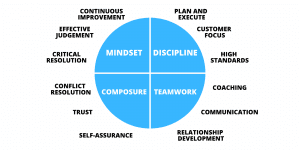The 9-box model is a widely used performance and potential matrix that is an incredibly helpful tool for succession planning and development. Although the tool has been available to the public for a long time, there are few who truly understand the intricacies of the mechanism and how valuable it can be when planning for the future and developing a leadership team.
Simple & Effective
The 9-box model is powerful because of its simplicity and effectiveness. From the experience of Predictive Success CEO David Lahey, the model works 95% of the time and only runs into trouble when communication is not transparent. The model is composed of 9 boxes arranged on an x and y axis grid, with performance measured along the x-axis, and potential measured along the y-axis. The most valuable position is the top right box, which is composed of those ranking high in both performance and potential. Conversely, the bottom left box is the place for those ranking low in both categories.
This illustration is a catalyst for constructive dialogue and in turn, will facilitate discussion, teamwork, and development. The idea behind the matrix is that by identifying how each employee fits into the grid, you can better understand where each employee stands and how they should be positioned in future organizational shifts.

For all 9-box models, a leadership competency model must be created. These models are made to highlight the leadership skills and behaviors that contribute to peak performance. When succession planning, a competency-based approach can help organizations decide best fit for their future leaders.

Addressing the Problem of Potential
Now it is easy to recognize the past performance of individual employees, but identifying their potential is a complicated task. A common difficulty experienced by users of the 9-box model is to accurately position their candidates onto the matrix, as well as determining an execution strategy for their succession plan. In addition, after the creation of a leadership competency model, identifying who fits best into their most competent leader pattern is often not done effectively.
Fortunately, there are tools available to help with these shortfalls. The Predictive Index (PI) has a vast product offering to assist in the implementation of the 9-box and leadership competency model, as well as formulating succession planning strategies. Predictive Index has been providing behavioral analytics software for over 60 years, and has undergone consistent scientific studies to ensure the validity of their products. This has led PI to become a staple in the hiring and managing infrastructure of organizations worldwide. Below are some tools that are being used to complement these two model to ensure effective and accurate use.
The Predictive Index Behavioral Assessment is a free choice, stimulus response survey used to capture the true personality of the user. From this information, management can determine useful information to help determine job fit, management & communication strategies, onboarding plans, and much more. In regards to the 9-box model, the results of the PI assessment can be analyzed and interpreted to better understand the potential of each individual with respect to the job, resulting in a more accurate positioning on the matrix.
PI research states that cognitive ability explains ~26% of job performance. With that being said, the cognitive agility of a candidate is an important factor in determining their potential. The Predictive Index Learning indicator is an assessment tool used to establish an accurate reading of the user's cognitive agility. This tool, in combination with the Behavioral Assessment, would provide an accurate view of someone's potential. These along with the candidate's/current employee's experience will lead to an accurate positioning on the 9box Matrix.
Once you are able to accurately determine where an employee fits into the 9 box matrix, strategies must be utilized to help guide your employee towards overall improvement, and heightened leadership responsibilities. The leadership competency model is a useful tool to recognize different areas in which employees can work through to attempt to raise their leadership capabilities. Striving to create stronger leadership should be a goal of any group, and the Leadership Transition Program is formulated to help with just that. The 4 day workshop aims to provide strategies and ideas to help in the transition of employees and current leaders towards expanded leadership roles, which will aid in the efficiency of both the individual, and the group.
Organizational Chart
This feature is a valuable succession planning tool, as it illustrates the current organizational depth chart along with each employee's behavioral assessment. This provides a concrete picture that can be drawn upon to determine why employees are thriving or lagging in their current roles, and which may be best suited for promotional opportunities.
In short, the 9-box model is an effective tool in the succession planning process, however analytics software can help tremendously to obtain the most value from the matrix. Through the use of PI's behavioral and cognitive assessments, one can accurately position an individual on the matrix. Using the leadership competency model, you can easily identify areas that the organization or group can rely on to continually further their leadership capabilities. With the Leadership Transition Program and PI organizational charts, establishing development strategies and an effective succession plan becomes a simple and definitive process that will lead to a future of formidable leadership.
Click here to try PI and learn more about what it can do for you.





